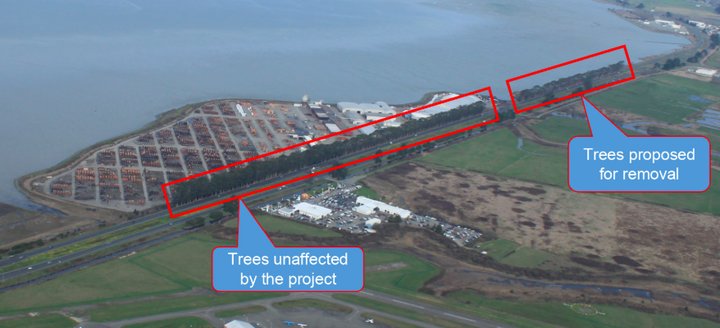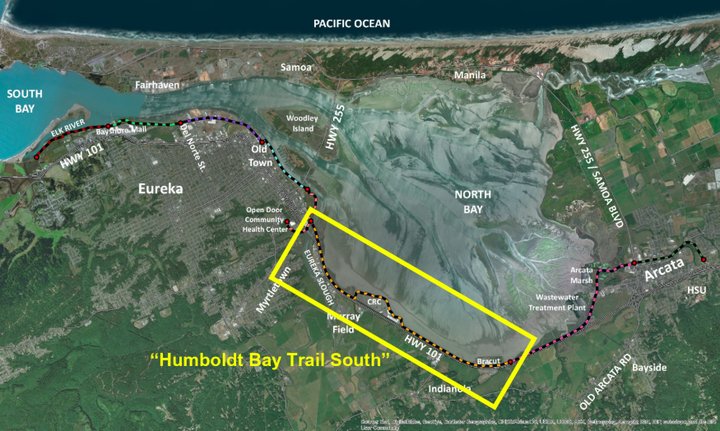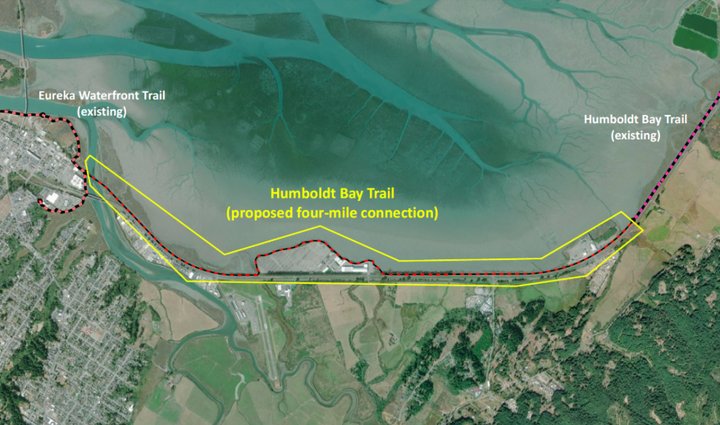
All images courtesy County of Humboldt.
The question of the day at Tuesday’s Board of Supervisors meeting was this: Would people rather have a Bay Trail connecting Eureka and Arcata or a half-mile stretch of eucalyptus trees?
Public speakers were split, with some arguing that cyclist safety and a regional trail system should take precedence while others defended the beauty and historic significance of those towering Eucalyptus globulus, aka Tasmanian blue gums, Australian giants planted nearly a century ago as windbreaks by a farmer named Henry DeVoy.
Hank Seemann, the county’s deputy director of environmental services, gave a long and detailed presentation explaining why, in the opinion of county staff, the northernmost 42 percent of eucalyptus lining the Highway 101 safety corridor must be removed if the county hopes to complete and maintain a non-motorized trail alongside the freeway.
But throughout the proceedings another question kept popping up: Can’t we have both? Trees and the trail?
Second District Supervisor Estelle Fennell, in particular, was reluctant to approve the staff recommendation, which was to adopt an environmental study that includes a plan to bring down those trees. Seemann explained that failure to do so at today’s meeting would jeopardize funding for the long-delayed trail project. But Fennell said she was deeply troubled by the prospect.
“This is extremely difficult because my heart goes with keeping the trees,” she said.
Ultimately, the board unanimously approved staff’s recommendation, including approval of a Mitigated Negative Declaration finding that after a series of mitigation measures the project won’t have any significant environmental impacts as defined under the California Environmental Quality Act (CEQA).
On paper this gives the green light to cutting down the eucalyptus trees. But with construction for that phase of the trail project not scheduled to begin until 2021 at the soonest, supervisors also directed staff to try one more thing in hopes of saving the trees. The county will hire two qualified, independent arborists to give a second and third opinion on whether the trees pose enough of a safety hazard to require removal.

Visual simulation of a cyclist crossing the train trestle bridge into Eureka.
The Humboldt Bay Trail project is inextricably linked to a freeway improvement project along the same stretch. The Eureka-Arcata Route 101 Corridor Improvement Project, led by Caltrans and the Humboldt County Association of Governments, received approval from the California Coastal Commission on the condition that a non-motorized trail also be permitted between the two cities.
In recent years Eureka has constructed nearly six miles of trail extending all the way along the city’s waterfront, and Arcata has built the Humboldt Bay Trail, which extends from the city through the Arcata Marsh and Wildlife Sanctuary and then south for a mile-and-a-half along the west side of Highway 101, coming to an end just north of the Bracut industrial park.

While there’s now just a four-mile gap between the two trails, that remaining stretch — dubbed Humboldt Bay Trail South — is filled with logistical and bureaucratic challenges, which include establishing rights-of-way through private property; navigating culverts, driveways and the railroad prism; resolving various permitting entanglements; removing a billboard that’s in the way; and, of course, those eucalyptus trees.
(There’s also the question of whether the cash-strapped North Coast Railroad Authority, which owns much of the proposed right-of-way, will even continue to exist as an agency, and if it doesn’t what effect that will have on government policies and permit negotiations.)
Seemann recounted the history of the trees, from their planting circa 1920, before that stretch of Highway 101 had even been paved, through a mid-century freezing event that forced many of the trees to be cut down and into the present day, when the trees are considered by many to be a historically significant visual landmark.
Seemann said county staff evaluated five lines of evidence to support their conclusion that the trees are simply too dangerous to remain next to the proposed trail.
The species is highly prone to sudden limb drop, even when the trees look healthy.
People using the trail, which is intended to accommodate folks of varying physical abilities, will be extremely vulnerable, passing directly beneath these trees.
A high number of trail users are expected during peak commuting hours.
Given the location and surrounding environment, a tree maintenance program would be extremely challenging, requiring near-constant specialized work.
Since the trees were planted — as opposed to the native redwood forests filled with trails locally — the government is legally responsible for public safety. “There’s no question that the county and Caltrans would be sued if there was an injury,” Seemann said.
While the trees definitely serve as a visual landmark around the Humboldt Bay, Seemann noted that aesthetics are subjective. Some who commented on the project said they’d prefer open views of the bay, and since the county is proposing the removal of less than half of those trees, staff concluded that the visual impact won’t be “significant,” as defined by CEQA.
Staff also concluded that these non-native and poisonous trees don’t qualify as a significant biological resource, nor do they meet the standards to qualify as California historic resources.
Lastly, Seemann noted that the end of August marks the deadline for submitting a package to the state to request funding, and the CEQA document must be approved as part of that submittal. In other words, failing to approve the environmental document today could cause massive delays and jeopardize funding for the project.

The proposed trail route would connect to Eureka via a train trestle bridge, go around the western, bay side of the California Redwood Company mill and hook up to the existing Humboldt Bay Trail leading north to Arcata.
Twenty-one people addressed the board on this matter, with 12 urging them to accept staff’s tree-removal recommendation. One woman, an endurance cyclist named Elaine, said she was initially skeptical of the call to remove the eucalyptus but changed her mind after riding that stretch of road.
”As a cyclist I can tell you they’re dangerous,” she said of the trees. The fallen branches and seed pods created “an obstacle course I could not safely pass through.”
Colin Fiske, executive director of the nonprofit Coalition for Responsible Transportation Priorities, said, “I understand the love of big trees, but eucalyptus are a non-native species that offer no ecological benefit.” Besides, he said, the Bay Trail could “unleash a transportation mode shift,” boosting bike commuting and tourism while supporting efforts to combat climate change.
But others took a stand for the trees. Stephen Rosenberg of Eureka said they provide a buffer from traffic noise and offer nesting opportunities for waterfowl. Removing them, he said, would be a “tremendous waste of taxpayer dollars when all of our roads are deteriorating.”
Mary Ann McCulloch of the Eureka Heritage Society said she begged to differ with county staff’s conclusion on the trees’ historic significance. How can trees that have had such an effect on the visual landscape and have been around for close to 100 years not be considered historic, she asked.
Bill Pierson, owner of Pierson Building Center, also defended the trees, saying their visual power lies in the unbroken mile-and-a-half expanse of them. Take 42 percent away from the Eiffel Tower or the Great Sphinx of Giza and you’d be left with just “a shadow, a pale comparison” of the original, he said.
Once everyone had spoken his or her piece, the board began their deliberations. First District Supervisor Rex Bohn was absent because, according to Board Chair Ryan Sundberg, he was over in Redding cooking food for evacuees of the devastating Carr fire. But he’d called Fourth District Supervisor Virginia Bass this morning with his opinion on the issue.
Bohn was “completely in support” of the staff recommendation to remove the trees and has “complete trust” in Seemann, Bass said. His only caveat was that he doesn’t want any county funds spent building the trail while our roads are falling apart, Bass said.
Fennell was really the only supervisor to express strong resistance to tree removal.
“I have a hard time understanding how we can’t figure out how to have both the trail and the trees,” she said. Could the trees be trimmed? Could the trail be closed on windy days?
Seemann reiterated staff’s conclusion that removal was the only way to avoid the safety hazard presented by the eucalyptus, and Public Works Director Tom Mattson backed him up.
“We understand that people love these trees, but our responsibility is to protect the public,” Mattson said.
Fennell asked if there was any way to move forward with the project, approving the environmental document while preserving the possibility of modifying the plans down the road, possibly saving the trees.
Seemann glanced at Mattson before suggesting that the board could direct staff to retain one or two certified arborists and have them conduct their own detailed tree risk assessments. Maybe they’ll validate staff’s conclusions or maybe they’ll say there’s another way. But since construction isn’t scheduled to begin for at least three years there’s at least time to look into it, Seemann said.
Third District Supervisor Mike Wilson made a motion to accept staff’s recommendation, and he proved amenable to Fennell’s arborist request. Seemann said the arborist assessments will likely cost at least $10,000 and take several months to complete. Fennell suggested maybe some of the tree defenders might volunteer to fund such a study and several in attendance raised their hands in affirmation. But Wilson said it might “muddy the waters” to have the assessments funded by “advocates.”
Wilson said he’s in favor of “whatever it takes to get a trail.”
So the board directed staff to retain two arborists to conduct detailed risk assessments and consider a variety of scenarios — from full tree removal to more conservative mitigation efforts. Staff will return to the board with their findings down the road.
In the meantime, the board’s unanimous approval of staff recommendations today means the county can pursue state funding for the last remaining stretch of the Humboldt Bay Trail. And while some type of mitigation measure isn’t beyond the realm of possibility, the bottom line is this: The county has approved the removal of more than 200 eucalyptus trees.
###
PREVIOUSLY
CLICK TO MANAGE